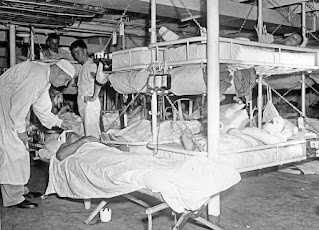Those Americans fighting the Japanese who were unlucky enough to be wounded during the invasion of Saipan (Operation Forager) in June and July 1944 were sometimes lucky to be routed for care not to the crowded bunks of transports, but to one of four, spotless white hospital ships—the Relief, Samaritan, Bountiful, and Solace. (For the Saipan operation, no more than 20 percent of the wounded could be taken aboard one of the specialized vessels.)
“The hospital ships’ names sound like funeral wreaths,” said Robert L. Sherrod, correspondent for Time/Life magazines, “but, actually, they were the most cheerful ships in the Pacific, and only about one per cent of the patients died before reaching a rear-area hospital.”
On a visit he paid to the Solace, which in civilian life had been the Clyde Mallory liner SS Iroquois taking passengers on the New York to Miami run, the correspondent found a different world than the one he had experienced on the island—a visit he shared in sometimes graphic detail for the era with readers of Time.
The sailors, attendants, doctors, nurses, and corpsmen on the ship were all clad in white, “contrasting sharply with other ships’ blue-dungareed sailors, and with the dirty, sweaty, bearded soldiers and marines whom they serve,” he said. Everything about the Solace, which had already evacuated one load of wounded men from Saipan to Guadalcanal, and the other hospital ships, were designed to make the more than 500 wounded men it sheltered “forget about mud and foxholes, the blackout and whine of artillery shells. Most soldiers, when asked about their main impression of battle, would probably name the dirt and filth. That is one reason why every effort is made aboard the Solace and her sister ships to keep everything white,” said Sherrod.
On a tour of the Solace, led by Doctor Howard K. Gary, a famous Mayo Clinic surgeon, Sherrod visited its six double-bunked wards, a three-tiered convalescent ward, five operating tables, an X-ray room, pharmacy, and all the other furnishings of “a first-class hospital.” Gray expressed his amazement to Sherrod about how well the men were able to recover from their often ghastly injuries.
“Good food, plenty of fluids, and some rest work wonders for them,” the doctor told Sherrod. “What they get is the best of attention, with a salt-air luxury-cruise thrown in. The equipment and the doctors aboard here are as good—or better—than they could get back home.” (On the Solace’s first trip from Saipan to Guadalcanal, the ship had lost only six patients out of the 583 it carried.)
According to Sherrod, to the marines and soldiers arriving from the battlefield’s filth, the most wonderful thing about the ship was the food it served. “The night I was there supper was chicken a la king and strawberry ice cream—honest-to-God, cold ice cream,” Sherrod exclaimed.
For his part, during his time on the Solace, the one thing that had impressed Gary was the courage and sense of humor shown by those wounded. One severely injured marine had been shot by an enemy solider standing only a few feet away from him and had a large portion of his chest blown out. The man somehow survived, and when doctors were able to talk to him they discovered that his attitude was one of "complete disgust" with Japanese marksmanship, Gray told Sherrod. “He said, ‘If that had been a marine he would have shot me square through the forehead.’”
Watching wounded men being loaded aboard the ship at about seven o’clock in the evening, Sherrod observed Doctor Richmond Beck, a psychiatrist by trade, act as the Solace’s embarkation officer, routing the injured into the proper location—“Medical One,” “Medical Two,” “Orthopedic,” etc.—as they were brought in from the portside and starboard gangways.
“After examining one particularly bloody case Dr. Beck said, ‘There is a delicate one. Looks like he got a hand grenade between his legs but I think we can save one testicle.’” Beck also handled a marine with a shattered kneecap; a man shot through his thigh; another who had at least five wounds in his chest, neck, and right arm; and another with a chest wound.
Each man received a white, cardboard tag from a compartmented box, Sherrod noted, and when the tags were gone, the doctors knew they had a full shipload. “The clothes of each wounded man were cut off him and thrown overboard,” said Sherrod. “The ship carried 2,000 pairs of fresh dungarees for those who could wear them when they were ready to go ashore at some distant time."



No comments:
Post a Comment